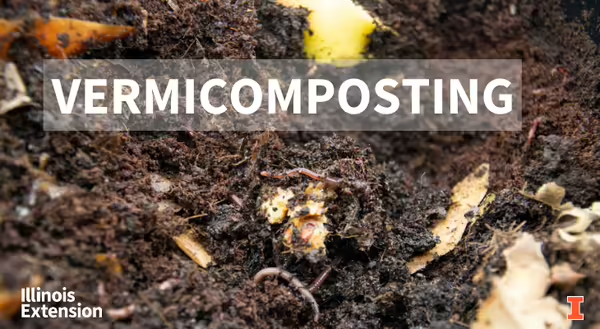
Being two weeks into the new year, I hope those of you with new goals of healthier eating are still going strong. If things didn’t work out the way you had planned, no worries; vermicomposting can help you get rid of all those fruits and vegetables that have gone bad and provide a nutrient rich material that can be added to our plants. Vermicomposting is the process of using various species of worms to decompose organic waste such as food scraps. It is also a great option for winter composting when our outside pile has become dormant.
How to start vermicomposting
You will need a 10 to 14-gallon lidded, plastic storage container. Prior to using your bin, rinse it with tap water to remove anything that might be harmful to worms. You’ll want to make holes in the container to allow air movement through the container as the process requires oxygen. You can also make holes in the bottom of the container to allow for drainage, but you will need another container to set your vermicompost container in to catch the excess moisture.
Vermicomposting supplies
Once you have decided on a bin, it is time to prepare a bedding of moist newspapers for your worms in the bin. Newspaper works well for this, but colored print should not be used as it may be toxic to the worms. Tear enough newspaper into strips 0.5 to 1” wide to fill your bin ¾ full of damp newspaper. You will need to moisten the newspaper strips enough that they feel like a damp sponge, but not dripping wet. It is suggested to do this in a different container to drain off any water sitting in the base; you can also add dry strips to the moistened bedding if it becomes too wet. Strips should provide a fluffy bed for the worms; compacted bedding does not allow for enough oxygen movement for the worms.
Worm selection and care
After preparing the bedding, the worms and 2 to 4 cups of soil from your yard can be added to the bin. Regular worms from the garden DO NOT work in a compost bin. The best worm used in vermicomposting is the Red Wiggler, or Eisenia fetida; these can be found as fishing bait or ordered online. If you have friends that vermicompost, they should also have worms to share. In an optimal environment, eight red wigglers can produce about 1500 new worms in six months. Optimal bin conditions consist of the following:
- Temperature between 55 to 77 degrees Fahrenheit
- Aerobic environment (with oxygen)
- pH range around 7 (neutral)
- Moist environment (65 to 75% with no standing water)
Your worms will eat fruit and vegetable scraps, tea leaves, coffee grounds, filters, and other non-greasy foods; DO NOT feed them meat, bones, fat, dairy products, greasy foods, or nonfood items (plastic, Styrofoam, etc.) Worms can eat about half their weight each day; therefore, the more worms you have, the more food you will need to feed them. Covering the food with the paper bedding can help to prevent fruit flies. If you do find that your worms are dying or not doing well in your bin, it could be the result of the following:
- Not enough food in the bin
- Has the worm population gotten too large; should it be divided?
- Bedding is too wet or too dry
- Bin temperature: is it too hot or too cold?
- Is there enough bedding or does it need replaced?
After about 8 weeks, enough worm castings should be available to start removing them from the bin. Rather than emptying everything out, you can start feeding the worms on one side of the bin bringing the worms to that side allowing you to remove the compost from one side of the bin and start feeding it to your plants!
Good Growing Tip: Chopping your food up into smaller pieces or cooking it before feeding it to your worms will help the worms decompose food quicker. This should especially be done with vegetables with thick stalks like broccoli and cauliflower.